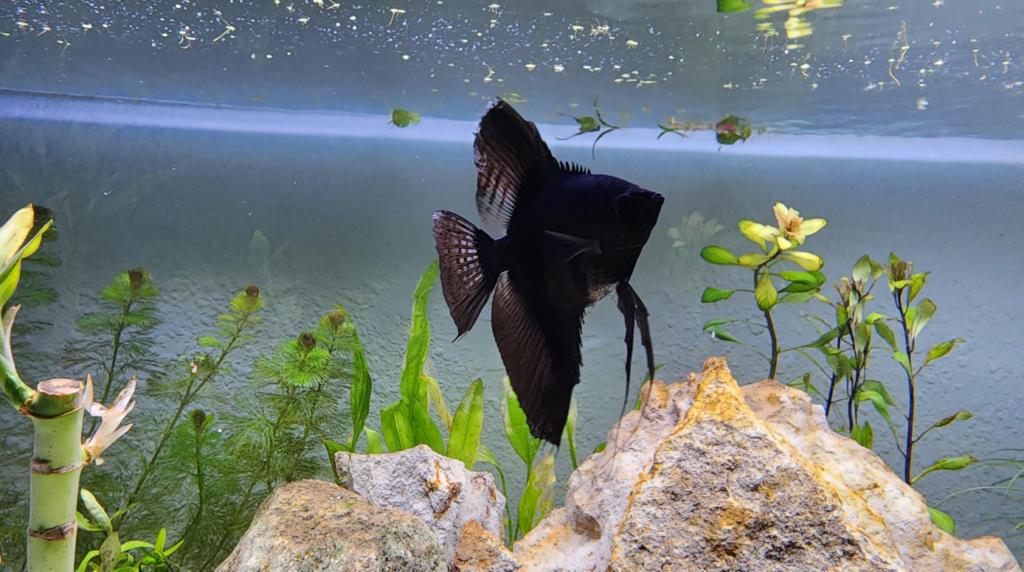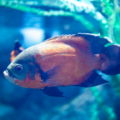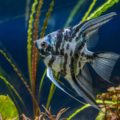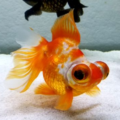Everything you need to know before breeding a Black Lace Angelfish in a community tank plus care, health, feeding and diet tips for a healthy life.

Introduction to Black Lace Angelfish
Ornamental fish species are always at the top of the list when choosing pets for indoor and outdoor aquariums. Fish keepers make choices ranging from basic fish to elegant aquarium fish that sure to capture guests’ attention at first glance.
With so many species existing in the world today, the freshwater angelfish is fast becoming a fan favorite. That’s why today, I’m highlighting one of the striking varieties of this species, the Black Lace Angelfish.
Black Lace Angelfish not only has a striking appearance but also some peculiarities that make it deserve a closer look. If you’re interested in learning all about this freshwater angelfish, keep reading.
History and Natural Habitat
I love starting these complete guides with fun facts and history lessons. So, let’s dive into the Black Lace Angelfish’s origins. Like many other angelfish, this species’ breeding history is traced down to selective creation in captivity.
Its natural habitat is the South American Amazon waters, but it has since found its way to North America and across the world through ornamental fish breeding practices.
That’s why, although it looks like a regular angelfish in shape and size, its fin, coloration, and scales are different.
Physical Characteristics

You’ve seen a preview of the Black Lace Angelfish’s appearance at the beginning of this guide, so let’s get into the details. I’ll start with the physical characteristics and then get to its unavoidable ornamental fish traits.
Physical Characteristics
Like every other angelfish, the Black Lace variant has a triangular shape with a lateral body that grows about 6 – 8 inches as an adult. However, it also has some unique features, including its deep black coloration with white or silver patterned fin scales that resemble lace.
Its fin structure is also longer, sharper, and wider, which gives it a graceful, flowing look when swimming. A closer look at the dorsal and anal fins shows you a fringe on the fin’s edge.
Ornamental Fish Traits
Your Black Lace Angelfish would appreciate having a partner or two in its tank, but it can get territorial. This species doesn’t like stress and loves having space to show off its long-flowing fins. So, ensure your tank isn’t cramped.
Care Requirements for Black Lace Angelfish
With your new insight into the Black Lace Angelfish’s unique physical characteristics and ornamental fish traits, you should already expect these customized care tips. The good news is that Black Lace Angelfish care is simple.
Firstly, you must observe basic freshwater fish care essentials, such as maintaining good water quality and parameters similar to their natural habitat.
Then, you must go the extra mile and adopt healthy aquarium maintenance tips like changing 20 – 30% of your tank’s water bi-weekly, ensuring the nitrogen cycle is established, and using a good filtration system.
Finally, use some of the health tips I’ll share in this guide to lengthen your pet’s lifespan. Before we get deep into the science of Black Lace Angelfish’s longevity, here’s what your ideal tank should look like.
Ideal Tank Setup for black Lace Angelfish

Because the angelfish has a vertically long body, your ideal tank setup should be tall and hold a minimum of 20 gallons of water for a single fish. If you have smaller pairs or groups, you can increase the gallons to 30 – 40 to give the fish enough space to move.
Use the natural habitat as the inspiration for your aquarium design. It’ll help your Black Lace Angelfish grow if it’s in a comfortable and happy species familiar environment.
Ideal Tank Conditions
- Water Temperature: 76 – 82℉
- pH Level: 6 – 7.5
- Hardness: 5 – 20 dGH, soft to moderately hard.
- Lighting: Moderate.
- Current: Gentle and Slow.
When choosing the aquatic decor for black lace angelfish, consider its sensitive scales and elegant fins. Use soft substrates like fine gravel, smooth pebbles, or sand for harmless movement. You can also add soft plants and smooth rocks for hiding and encouraging natural territoriality.
Remember, you must create an optimal tank environment if you want your pets to have the best life.
Feeding and Diet
It’s time to discuss feeding habits. If you’re a pro fishkeeper, you already know this species is a messy eater, but it’s not selective. It can digest plant-based and live food as long as it’s nutritious fish food.
Prepare a balanced diet meal for your Black Lace Angelfish by mixing commercial pellets or flakes rich in vitamins and protein with live food like brine shrimp and bloodworms for shiny and healthy skin.
Avoid overfeeding your pets by serving them little portions of food they would finish in less than three minutes and feed them only twice max daily. If you notice your Black Lace Angelfish are already overeating, you can add blanched vegetables like zucchini and spinach for fiber to their diet.
For more on feeding your aquatic pets check out The Ultimate Guide to Fish Food: Pros and Cons & Best Choices!
Next, let’s check out more health issues and common diseases unrelated to poor feeding habits and how you can tackle them.
Health and Common Diseases
Because of their physical traits, you can already imagine the kinds of common fish ailments that will affect this angelfish variety. But there’s no need for that since I’ve already brought the answers to your screen. Here are some common diseases, causes, and fish disease prevention tips to save your beloved pets.
Fin Rot
- Signs: Fraying fins, Damaged Fins
- Cause: Bacteria
- Treatment: Antibiotics Cream, Water Change
- Prevention: Good Quality Water
Dropsy
- Signs: Swelling, Pinecone (Raised) Scales
- Cause: Internal Infection, Poor Water Quality
- Treatment: Antibiotics Medication, Water Change
- Prevention: Good Water Quality
White Spot
- Signs: Cotton-like white spots on fins
- Cause: Protozoan Infection
- Treatment: Copper-Based Medication, Heat Therapy
- Prevention: Moderate lighting in the Aquarium
For more details checkout our article on How to Treat Ich Outbreaks in Your Freshwater Fish!
Velvet (Oodinium)
- Signs: Dusty skin
- Cause: Protozoan infection
- Treatment: Copper-based treatments, Velvet Medication
- Prevention: Moderate lighting and water heating periodically.
More fishkeepers need to pay closer attention to aquatic health care if they want their water-dwelling pets to live longer-lasting lives. Always quarantine new fish before introducing them to the community tank, and feed your pets a balanced diet.
If you want to breed Black Lace Angelfish, you must follow the right processes outlined below.
Breeding Black Lace Angelfish

Before we start, do you have a separate tank for breeding? If not, is your tank large enough for a boundary? If not, then get a new tank to breed your Black Lace Angelfish. It would help if you had separate breeding tanks because the water conditions for Angelfish reproduction are different.
The pH level for breeding tanks increases to 7.5, although the temperature stays relatively the same. Other breeding tips include:
- Breeding Pairs: One adult male and one adult female
- Spawning Prep: Flat surface for the eggs, including a spawning mop
- Spawning Behavior: The male chases the female and nudges her belly to lay eggs on the flat surface. She enters the hidden spot and lays her eggs for the male to fertilize them externally.
This video has been very helpful in identifying the sex of angelfish, I highly recommend it:
Fry-Rearing Tips
After fertilization, the eggs will hatch within two to three days. The young fish fry will feed on their yolk sacs, and then it’ll be your turn to feed them infusoria. By the fourth to sixth days, you can add crushed pellets or flakes to their diets.
At this stage, you’ll see the fry growing larger. Some will grow faster than others, and you must monitor them to prevent predation. As they grow, separate the bigger fry from the smaller ones. Successful fish breeding only happens when you pay attention.
Black Lace Angelfish aren’t typically aggressive, but when they sense competition, they get agitated and territorial, leading to predatory behaviors.
Behavior and Compatibility
Throughout this guide, I’ve hinted at certain traits this variety shares with its fellow species, but there’s more to unravel about the Black Lace Angelfish’s behavior. If it doesn’t mind being in pairs or groups, which species are the most compatible with its temperament?
Black Lace Angelfish Behavior
Black Lace Angelfish is the leader of the school. So, even when it’s with other fish or water-dwelling species, you’ll notice that your pet is at the top of the ladder. It asserts dominance by marking specific areas as its territory in the community tank.
You won’t stress much about managing angelfish interactions because they can be social. The Black Lace Angelfish will bond with its tankmates but only when it wishes. Otherwise, this species enjoys swimming alone and exploring its environment.
Compatibility with Other Fish
If you’re into curating peaceful fish communities, here are some tankmates that are compatible with Black Lace Angelfish:
- Corydoras Catfish

- Guppies

- Rainbowfish

The compatibility test is to check if the other species are submissive enough to allow your Black Lace Angelfish to assert dominance without getting aggressive. But they should also not be too small to become prey.
Avoid Neon Tetras, Convict Cichlids, and Barbs.
Also, remember that the tankmates must have the same water condition requirements as the Black Lace Angelfish so they don’t freeze in the cool waters.
Conclusion
That’s a wrap on the Black Lace Angelfish care overview. You’re now ready to start your Aquarium with as many of these species as you can handle. Surely, this guide gave you a new outlook on angelfish appreciation and how they can spice up your Aquarium.
Before saying goodbye, here’s a quick recap to see if you’ve been paying attention.
- Black Lace Angelfish requires ornamental fish care
- They’re omnivores, so feed them a balanced diet
- The best disease prevention is having optimal water conditions
- Always use a separate breeding tank
- Pair Black Lace Angelfish with calmer tankmates
Now you’re good to go! If you need more aquarium maintenance advice, you can always come back.










